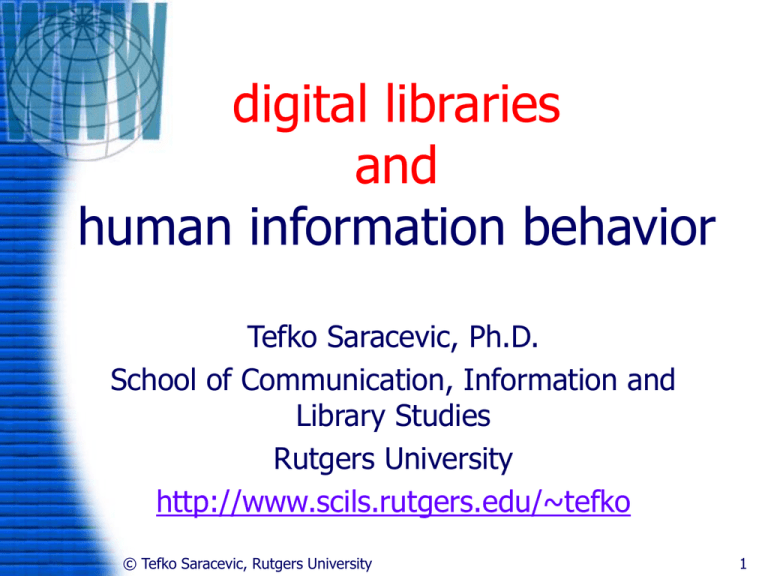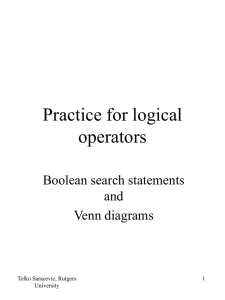Dig libraries and HIB LIDA.ppt
advertisement

digital libraries and human information behavior Tefko Saracevic, Ph.D. School of Communication, Information and Library Studies Rutgers University http://www.scils.rutgers.edu/~tefko © Tefko Saracevic, Rutgers University 1 digital libraries • global phenomenon – many institutions & fields involved – many research efforts & programs – many practical developments in and beyond libraries – large expenditures in research & practice – applications & use growing exponentially – huge effects, some unpredictable – but study of human aspects relatively neglected © Tefko Saracevic, Rutgers University 2 what are digital libraries? • no neat answer - a number of conceptions with varying emphasis on: – digital content, objects • creation, management, representation, organization, preservation – access • availability, services, interfaces – use, users, communities – technical infrastructure, networks, – institutional context, policies, cooperation © Tefko Saracevic, Rutgers University 3 where do humans fit? • digital libraries support users in informational tasks and needs – what are people doing? – how are people engaging with d-library • as yet, we are not sure • what processes & variables to observe • what context & effects to include • what models, criteria, measures, methodologies to use © Tefko Saracevic, Rutgers University 4 dl research • most done on – technical aspects, content handling, organization, operations, access tools … • in comparison human information behavior was investigated much less – still there are a number of studies in a variety of countries • here we surveyed some 50 studies © Tefko Saracevic, Rutgers University 5 context of studies • some studies indeed concentrated on human information behavior in d-libraries • but, most were a part of d-lib evaluation – users used various features/processes – i.e. evaluation was goal and findings on human information behavior were a byproduct • d-library evaluation & studies of human information behavior are mixed together © Tefko Saracevic, Rutgers University 6 methods used • • • • • • surveys interviews observations think aloud focus groups ethnographic analysis © Tefko Saracevic, Rutgers University • • • • log analysis record analysis experiments given task accomplishments • economic preferences • you named it! 7 classes of variables studied • users – who uses a d-library? • features – what features are used? • access – how is it used? • use – what content is used? for what? • usability – ease? effectiveness? • outcomes – with what results? © Tefko Saracevic, Rutgers University 8 users • population, reasons – who uses a given d-library and why? • tasks, queries – what is their nature? • knowledge, understanding – what knowledge & learning needed? • preferences, expectations – what is preferred? expected? © Tefko Saracevic, Rutgers University 9 features • features – what available features in a d-library are being used? • frequency & amount – how much are they used? distribution? • patterns – what may be patterns in use of any feature? • individual differences – how do individuals differ in use of features? © Tefko Saracevic, Rutgers University 10 access • access – how? from where? how often? repeated? • discovery – how searched, navigated, browsed, retrieved? • time, effort – what does it take to use & find? © Tefko Saracevic, Rutgers University 11 use • distribution – how many items in collection used? • application – for what were the items actually used? • social – what are social practices associated with digital library use? © Tefko Saracevic, Rutgers University 12 usability • effectiveness – how well are given user tasks accomplished? • efficiency – at what cost, effort, time? • ease – how easy are interfaces & features to use? • barriers – what hindrances? frustrations? lost? • learning effort – how much needs to be learned? how? errors? © Tefko Saracevic, Rutgers University 13 outcomes • downloads – what & how much is downloaded? • assessments – what value? relevance? usefulness? satisfaction? • effects – what impact on activities? • e.g. education, scholarly communication © Tefko Saracevic, Rutgers University 14 some interesting results • users – half are repeated users • features – many not used • access – varies by nature of desired materials – users vary in skills & understanding © Tefko Saracevic, Rutgers University 15 results … • use – 80 – 20 rule seems valid – a small proportion of collection is used – downloads are significant • usability – many barriers to use – effectiveness varies greatly – frustration is easily triggered © Tefko Saracevic, Rutgers University 16 results … • outcomes – many queries do not lead to viewing – text materials not appealing – valuing varies with age © Tefko Saracevic, Rutgers University 17 studying inf behavior in d-library context • impossible? not really • hard? very • mostly subsumed under d-library evaluation • could not generalize yet • no theories • no general models emerged yet, although some proposed – here is one © Tefko Saracevic, Rutgers University 18 model for studying human inf behavior in digital libraries users, tasks, contexts features access use seeking inf usability outcomes © Tefko Saracevic, Rutgers University 19 users and digital libraries • a number of studies reported various versions of the same result: users have many difficulties with DLs – usually do not fully understand them – they hold different conception of a DL from operators or designers – they lack familiarity with the range of capabilities, content and interactions – they often engage in blind alley interactions © Tefko Saracevic, Rutgers University 20 but is it: user AND digital library or user VERSUS digital library • why VERSUS? – users and d libraries see each other differently © Tefko Saracevic, Rutgers University 21 analogy • perceptions of users and perceptions of designers and operators of a DL are generally not very close • users are from Venus and DLs are from Mars • leads to the versus hypothesis © Tefko Saracevic, Rutgers University 22 user AND digital library model digital library model of user context task cognitive digital library user affective competence context content representation organization services user model of digital library © Tefko Saracevic, Rutgers University 23 how close are they? user VERSUS digital library model user model of digital library what user assumes about digital library: how it works? what to expect? © Tefko Saracevic, Rutgers University digital library model of user what digital library assumes about user: - behavior? - needs? 24 the versus hypothesis in use, more often than not, digital library users and digital libraries are in an adversarial position • hypothesis does not apportion blame – does not say that DL are poorly designed – or that users are poorly prepared • adversarial relation may be a natural order of things © Tefko Saracevic, Rutgers University 25 technological imperative • human information behavior in dlibraries quite different then in traditional libraries • behavior related more to technology side then library side © Tefko Saracevic, Rutgers University 26 conclusions • research on human information behavior in d-libraries still in infancy • not funded much, if at all • but necessary for understanding how to build better d-libraries and services © Tefko Saracevic, Rutgers University 27 How to do it? inf behavior digital library © Tefko Saracevic, Rutgers University 28 sources • URLs for the mentioned and other literature dealing with studies on: – evaluation of digital libraries – human information behavior in DL – evaluation of metadata – usability tests can be found on: http://scils.rutgers.edu/~miceval © Tefko Saracevic, Rutgers University 29 © Tefko Saracevic, Rutgers University 30 © Tefko Saracevic, Rutgers University 31







